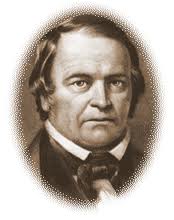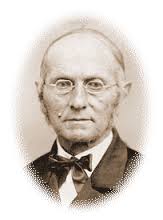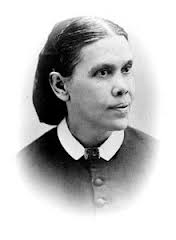Seventh-day Adventist History
In the years immediately following the second great awakening in the
United States, several religious movements were formed. The
current attitude toward prophecy was that the world would keep getting
better and better until the millennium. However, one William
Miller, a Baptist farmer, studied the Bible beginning with Genesis
1.  He didn’t leave a text until he thought that he understood it. When he
got to Daniel 8:14 he realized that the implications were that Christ
was coming soon to judge the earth. He calculated that the 2300
years had started in 457BC. He figured, incorrectly that the
ending date would be 1843. Miller started preaching in the
neighboring towns and soon ministers of other denominations
gathering around Miller also began preaching that Jesus would be
coming soon. The date came and went and Jesus had not
returned. Restudying, he and others realized that he had
miscalculated and that the year was really 1844 and that the day which
corresponded to the Jewish day of atonement was October 22.
Again the date came and went and Jesus had not returned. The
believers were devastated. Some had left their crops in the
fields believing that Jesus would come back before harvest time.
That time period is known to the various adventist denominations that
arose as the Great Disappointment.
He didn’t leave a text until he thought that he understood it. When he
got to Daniel 8:14 he realized that the implications were that Christ
was coming soon to judge the earth. He calculated that the 2300
years had started in 457BC. He figured, incorrectly that the
ending date would be 1843. Miller started preaching in the
neighboring towns and soon ministers of other denominations
gathering around Miller also began preaching that Jesus would be
coming soon. The date came and went and Jesus had not
returned. Restudying, he and others realized that he had
miscalculated and that the year was really 1844 and that the day which
corresponded to the Jewish day of atonement was October 22.
Again the date came and went and Jesus had not returned. The
believers were devastated. Some had left their crops in the
fields believing that Jesus would come back before harvest time.
That time period is known to the various adventist denominations that
arose as the Great Disappointment.
While walking across a cornfield to visit and encourage other believers, Hiram Edson suddenly realized that their assumption that the earth was the sanctuary to be cleansed was incorrect. The Bible stated that there was a sanctuary in heaven. Suddenly it all made sense. Christ had not come to earth but rather had gone from the Holy Place to the Most Holy Place in the heavenly sanctuary to begin the pre-advent judgment.
One of the adventist preachers was the Methodist Frederick Wheeler
living in New Hampshire. In response to his sermon wherein he
admonished the congregation to keep all of the commandments of God,
Rachel Oakes, a Seventh Day Baptist present in the congregation
challenged him to keep all of them himself including the fourth
commandment.  After
study and soul searching he decided that the seventh day of the week
is the true Sabbath of the Lord and began to keep it. Several
members of his congregation joined him in the observance of Saturday
Sabbath. Soon tracts were printed and Joseph Bates, a former sea
captain, read one. He found the evidence convincing and spread
the news that Saturday is the Sabbath everywhere he went. That
news soon reached Ellen and James White who accepted that truth.
Together, Bates and Ellen and James White became the leaders of the
Sabbath keeping adventists. But it wasn’t until 1863 that an
official church was formed with the name Seventh-day
Adventist.
After
study and soul searching he decided that the seventh day of the week
is the true Sabbath of the Lord and began to keep it. Several
members of his congregation joined him in the observance of Saturday
Sabbath. Soon tracts were printed and Joseph Bates, a former sea
captain, read one. He found the evidence convincing and spread
the news that Saturday is the Sabbath everywhere he went. That
news soon reached Ellen and James White who accepted that truth.
Together, Bates and Ellen and James White became the leaders of the
Sabbath keeping adventists. But it wasn’t until 1863 that an
official church was formed with the name Seventh-day
Adventist.
 One
of the doctrines of the church is the belief in the continuance of the
spiritual gifts. This includes the gift of prophecy. Ellen
White has manifested that gift through some 2000 visions and dreams
which she wrote out for the benefit of the church at the time and to
guide it in the future. By doing so she was instrumental in
shaping the doctrinal stance of the church. Her visions and
dreams ranged from seeing the battle between heavenly and Satanic
forces and its final outcome to visions dealing with health
topics. As a result the Seventh-day Adventist Church has long
considered health, education, publishing, work among the poor and
foreign missions of high priority. The mix of all these gives
rise to what might be called a sub-culture. Currently the
Seventh-day Adventist Church is one of the fastest growing churches in
the world. It has a world-wide membership of approximately
18,000,000 with approximately 30,000,000 adherents. It is truly
a world church with only about 7% of members coming from North
America.
One
of the doctrines of the church is the belief in the continuance of the
spiritual gifts. This includes the gift of prophecy. Ellen
White has manifested that gift through some 2000 visions and dreams
which she wrote out for the benefit of the church at the time and to
guide it in the future. By doing so she was instrumental in
shaping the doctrinal stance of the church. Her visions and
dreams ranged from seeing the battle between heavenly and Satanic
forces and its final outcome to visions dealing with health
topics. As a result the Seventh-day Adventist Church has long
considered health, education, publishing, work among the poor and
foreign missions of high priority. The mix of all these gives
rise to what might be called a sub-culture. Currently the
Seventh-day Adventist Church is one of the fastest growing churches in
the world. It has a world-wide membership of approximately
18,000,000 with approximately 30,000,000 adherents. It is truly
a world church with only about 7% of members coming from North
America.
Other sources you may wish to read can be found at
http://www.adventist.org/world-church/facts-and-figures/history
http://en.wikipedia.org/wiki/History_of_the_Seventh-day_Adventist_Church
